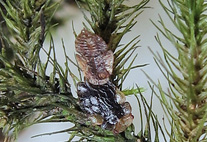Abstract
The genus Paraheligmonelloides Fukumoto, Kamiya and Suzuki, 1980 (Nippostrongylinae) is revised and split into four genera, mainly based on characters of the synlophe not previously considered at the supraspecific level. These characters mainly include the homology of the left ridge with ridge 1’, the relative size of the right ridge to the left ridge and to ridge 1’ and the distribution of the largest ridges. Paraheligmonelloides sensu stricto, characterized by the homology of the left ridge with ridge 1’, contains only the type species, Paraheligmonelloides kenyensis Fukumoto, Kamiya and Suzuki, 1980, parasitic in a lagomorph from Kenya. Krishnasamyos n. gen., characterized by ridge 1’ forming a comarete, two minute left ventral ridges and ridge 1 larger than other dorsal ridges, only includes the species Krishnasamyos triangulus n. comb., parasitic in Malaysian murids. Hughjonestrongylus n. gen., characterized by numerous ridges markedly unequal in size, with the largest ridges grouped in relation to the lateral fields, includes Hughjonestrongylus ennisae n. comb., Hughjonestrongylus amplicaudae n. comb., Hughjonestrongylus mirzai n. comb., and Hughjonestrongylus singauwaensis n. comb., all parasitic in murids from Papua Indonesia and Papua New Guinea. Syafruddinema n. gen., characterized by ridge 1 as long as other dorsal ridges and a gap associated with the left lateral field, between ridges 2’ and 3’, includes Syafruddinema paruromyos n. comb., Syafruddinema annandalei n. comb., and Syafruddinema eropeplios n. comb., parasitic in murids from Malaysia and Indonesia. A key to the proposed genera is provided.

